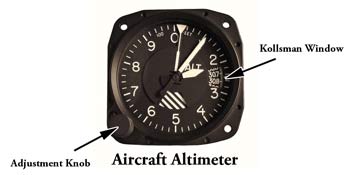|
Absolute Air Pressure Measurementupdated Jan
23, 2023 Here are some guidelines to aid in choosing a suitable measurement of
absolute air
pressure for accurate calculation of Density Altitude and/or Engine Horsepower. 1) Pressure measurements which are useful for calculating Density Altitude and/or Engine Horsepower:
To get a feeling for the magnitude of the absolute pressure, the absolute pressure in the idealized International Standard Atmosphere (ISA), on a standard day, is 29.92 in-hg at sea level. At 2000 ft the absolute pressure drops to 27.82 in-hg, at 4000 ft the absolute pressure is 25.84 in-hg, at 6000 ft the absolute pressure is 23.98 in-hg, and at 8000 ft the absolute pressure is 22.23 in-hg. Some methods to find the Absolute Pressure: a) Portable Devices: Many smartphones and tablets have Absolute Pressure sensors built-in, and there are many apps which can display the current value. For example, on Android devices: GPS Status - displays Absolute Pressure and GPS altitude Many portable digital weather stations can display the Absolute Pressure. For example: Kestrel 3500 Pocket Weather Meter
Many airports can provide their current Station Pressure. In the USA, the National Weather Service reports Station Pressure for many locations. See for example:
Method 1: The absolute air pressure may be directly read in the Kollsman window of a properly calibrated aircraft altimeter by turning the adjustment knob until the altimeter indicates an altitude of zero (if the altimeter has sufficient adjustment range to do so). However, this trick is of limited utility since the Kollsman window has a rather limited range.
Another method to obtain Absolute Pressure is to set the altimeter to 29.92, and then convert the resulting Pressure Altitude reading to the corresponding Absolute Pressure.
Here's a calculator which converts Pressure Altitude (which
is the altimeter reading when the Kollsman window is set to
29.92) to Absolute Pressure (for an ISA standard day):
Method 3: For the convenience of pilots, some of my on-line Density Altitude calculators utilize Altimeter Setting and Elevation rather than requiring the Absolute Pressure. For those without an altimeter, many airports can provide the current altimeter setting, and the altimeter setting is included in most US National Weather Service reports. Here's a calculator which converts Altimeter Setting and Altimeter Reading (Elevation) to Absolute Pressure (for an ISA standard day):
2) Air Pressure Measurements which are NOT recommended for use in calculating Density Altitude and/or Engine Horsepower: a) Absolute Barometric Pressure: This pressure measurement originally
measured the height of a column of mercury. However, since the
density of mercury is a function of temperature, the air
pressure measurements made with a mercury barometer are also a function of
temperature. In some specific circumstances, a
barometer may accurately indicate the actual ambient air
pressure. However, in general, due to the effects of
temperature, there will be
some difference between a barometer reading and the actual
air pressure.
Sea-level pressure is a theoretical pressure at the station if the station were actually at sea level. Unfortunately, there are a variety of slightly different methods used to convert from the actual barometric pressure to the sea-level corrected pressure. In general, conversion from actual
barometric pressure to sea-level barometric pressure
includes certain effects of temperature. And, due to the various sensors and algorithms which are employed in calculating the
sea-level barometric pressure, the accuracy of any
conversion from the sea-level corrected barometric pressure
to absolute pressure is unpredictable (unless the specific
type of sensor and the specific algorithm used to make the
sea-level correction are known).
|


